A tale of a Wicked Plant (aka “The Case of the Poisonous Monkshood”)
May 23rd, 2009
In preparing for a phone interview with prolific, bestselling author Amy Stewart to discuss her new book, Wicked Plants: The Weed that Killed Lincoln’s Mother & Other Botanical Atrocities, I came across a dog-eared manila folder in my office file drawer. Its label read “Emery’s Garden Monkshood.”
![aconitum Autumn Monkshood - beautiful and poisonous [photo from Valleybrook Gardens Ltd.]](https://www.slowflowerspodcast.com/wp-content/uploads/2009/05/aconitum-150x150.jpg) And immediately, I recalled my own brush with a “Wicked Plant.” Before sharing my Q&A with Amy, I will indulge in the tale of Autumn Monkshood, aka Aconitum carmichaelii ‘Arendsii’.
And immediately, I recalled my own brush with a “Wicked Plant.” Before sharing my Q&A with Amy, I will indulge in the tale of Autumn Monkshood, aka Aconitum carmichaelii ‘Arendsii’.In the late 1990s, I worked for a wonderful specialty nursery in Lynnwood, Washington, called Emery’s Garden. I had recently left business writing and a nonprofit communications gig to embark on my “garden writer” journey. Lucky for me, the people at Emery’s took me in and our relationship there flourished. I wrote and edited “The Weedy Reader,” our quarterly newsletter. I planned and produced our educational program and special events. I basically learned the horticulture business, thanks to Emery Rhodes, Marlis Korber and Amy Tullis.
After I left Emery’s in 2000 (that’s when I joined the team of The Herald’s “Home & Garden” section in nearby Everett), I stayed in close touch with my Emery’s pals. One day, in April 2001, I received a panicked phone call from Marlis, the nursery’s general manager.
Turns out, a customer purchasing perennials pointed out some odd tags on the 6-inch containers of Monkshood (Aconitum). The tag read: “All parts of this plant are tasty in soup.” The shopper had filled one of Emery’s carts with her two toddlers and three pots of the mislabeled (and wicked) perennial. “I thought this stuff was poisonous,” she said to our sales associate. “But this label says it’s edible.”
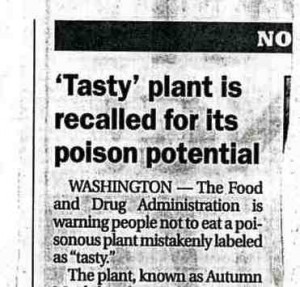
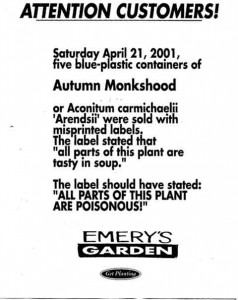 Needless to say, a check in Sunset Western Garden Book revealed the exact opposite to be true. Under “Aconitum,” Sunset warns: “All parts are poisonous if ingested.”
Needless to say, a check in Sunset Western Garden Book revealed the exact opposite to be true. Under “Aconitum,” Sunset warns: “All parts are poisonous if ingested.”
What resulted was a mini-international scandal and media frenzy. The common Monkshood, which is a beautiful, tall violet-blue ingredient in the cottage border, is NOT a tasty ingredient for soup or stews. Instead, it’s lethal.
The ensuing drama played out as you might expect. I got to play the role of Crisis-PR consultant while Emery’s pulled all the mislabeled plants, contacted the grower (a Canadian nursery), and soon discovered that the label mishap had been a stupid prank pulled by one of the grower’s employees! Within 48 hours, we were visited by the FDA; the Canadian authorities got involved; the plant recall went out over the wires; television, radio and print outlets picked up on the story and came to report on the scare.
In the end, it was a bit of a wake up call for Emery’s (and possibly other local nurseries) about the importance of using proper signage and labeling of toxic ornamental and landscaping plants. But I wonder, did anything really change? It certainly elevated consciousness at one nursery, at least for one season.
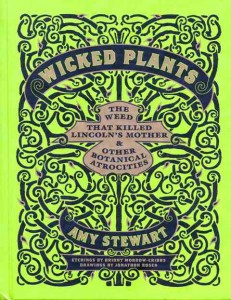 Now, however, with the advent of Wicked Plants, the evils of ingesting the flowers, stems or leaves of Aconitum are coming back to haunt me. The perennial is, in fact, the very first entry of Amy Stewart’s charming and horrifying new effort, published earlier this month. Amy writes:
Now, however, with the advent of Wicked Plants, the evils of ingesting the flowers, stems or leaves of Aconitum are coming back to haunt me. The perennial is, in fact, the very first entry of Amy Stewart’s charming and horrifying new effort, published earlier this month. Amy writes:
In 1856 a dinner party in the Scottish village of Dingwall came to a horrible end. A servant had been sent outside to dig up horseradish, but instead he uprooted aconinte, also called monkshood. The cook, failing to recognize that she had been handed the wrong ingredient, grated it into a sauce for the roast and promptly killed two priests who were guests at the dinner. Other guests were sickened but survived.
Her scary narrative explains where the perennial grows and what to look out for (gardeners should wear gloves anytime they go near aconitum, Amy advises). The page is labeled “Deadly.”
Wicked Plants, is a compendium of horrifying stories and historical facts of the botanical world. If you have any question as to the deadly, illegal, intoxicating, dangerous, destructive, painful and offensive traits of the trees, shrubs, perennials and herbs growing on our planet, you’ll want to peruse this powerful little volume.
Between the pages of Amy’s 5-3/4 x 7-1/4 inch, 235-page book, which is bound in the same sickly green worn on the face of the witch Elphaba in the musical “Wicked,” are tales of death, destruction, war and more. I recently had a chance to chat by phone with Amy, and here is part of our conversation:

Author Amy Stewart
What do you think of my story about the mislabeling of Aconitum?
Working on Wicked Plants made me very aware of how little labeling there is on (ornamental) plants. If we believe in the free market, then we expect consumers to have the right information to make their choices. Garden centers could handle this issue simply by posting information about whether plants are toxic. Most plants are NOT edible.
After your three previous books, From the Ground Up, The Earth Moved and Flower Confidential – I have read (and loved) them all – what inspired this book about plants and their wicked ways?
We all love to be frightened. The inspiration came while I was working on Flower Confidential, actually. You hang around greenhouses long enough and someone is bound to offer to show you their “wicked little plant.” Once I figured this out, I started making a list.
When you set out to write Wicked Plants, what was your goal?
I wanted it to be fun to read, even for non-plant people. This book builds a bridge between plant science and the popular imagination. And it was fun to do. This is not a plant ID book. It’s not a reference book. There’s just enough plant information to help flesh out a plant as a character.
How did you start your research, Amy?
It’s one thing to just know a plant is poisonous. There are some big, old $100 textbook-style references with good, long lists. It was my challenge to find plants with an interesting story. I wanted to bring the plant to life with a great tale – one that was true.
It’s mind-boggling to me to even think how you tackled this topic.
I started a database to catalog my books, my sources; I listed the possible plants and their traits.
Where did you dig up the evil “back stories?”
I went through old newspaper archives and obituaries going back well into 1800. I found great stories of plant poisoning that are 200 years old. Some are historical, like Socrates [who was killed by poison hemlock]. Others are published in medical journals as “case studies.”
What’s an example?
Academics seem to enjoy going back and looking at some incident and doing forensic study. For example, researchers looked at what was reported at the time of Claudius I, the Emperor of Rome’s death. He died under mysterious circumstances, but historians believe his symptoms point to poisoning by muscarine, a toxin found in several species of deadly mushrooms.
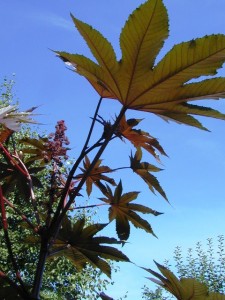
Beautiful but deadly, Castor bean in my former Seattle garden
I can’t resist asking: Do you have your own favorite wicked plant?
I really love Castor Bean (Ricinus communis). I used to be a test grower for Organic Gardening magazine and one year they sent me castor bean seed. I remember asking: Why would anyone grow this – it’s horrible! Now, I love it. It grows in my garden.
[Debra’s note: I love this plant, too. It’s definitely one to keep the pets and kids away from, but guaranteed to give a garden an exotic, instant-tropical look. Here’s a photo of some that I grew back in the day.]
That sounds scary. Tell me about your garden.
I started acquiring all these plants; some are pretty hard to get. I planted them outside my kitchen door in a fenced-off area with a gate.
Wicked Plants has its own exhibit this summer at the Brooklyn Botanic Garden, May through September. Kudos, Amy! Tell us how that came about:
I was inspired by an exhibit at the San Francisco Conservatory of Flowers called “Chomp,” about carnivorous plants. During that exhibit, they asked the author of Savage Plants to give tours. I realized it was a great way to connect with people.
I looked for a botanical garden with exhibit space (not all gardens have the room) and while I was touring Brooklyn Botanic Garden I met Scot Medbury, BBG’s president, and started going off on this idea with him. People who are not plant people look at public gardens as a place to see a pretty landscape. But when we start sharing the stories and history of plants, I think that’s when a connection is made.
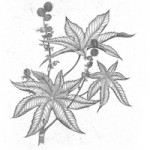
Briony's exquisite etching of the deadly Castor bean plant
So now there is an exhibit called “Wicked Plants,” that opened in May. You must be thrilled!
I can’t wait to see the exhibit. I’m speaking at BBG on May 31st and then later – on July 25 – I’ll lead a plant walk through the garden. I also narrated an audio tour of the wicked plants in the show.
I found Briony’s work in Seattle. She drew these crazy creatures, weird, wild stuff that has a very Victorian-gothic feel. Do you know her name comes from a poisonous plant – B. cretica?
Amy, you are an inspiration to anyone in the creative world. I love learning from you and trying to figure out how your amazing mind works.
Here’s to a very successful run with Wicked Plants!









May 24th, 2009 at 9:59 am
Yesterday, I was talking to a customer about this very incident as he asked me about
information on a plant label that was false. (scary movie music…)
June 14th, 2009 at 11:13 am
books to download…
Very insigtful information. I truly enjoyed reading it….
November 4th, 2011 at 7:30 pm
my blog…
[…]Debra Prinzing » Blog Archive » A tale of a Wicked Plant (aka “The Case of the Poisonous Monkshood”)[…]…